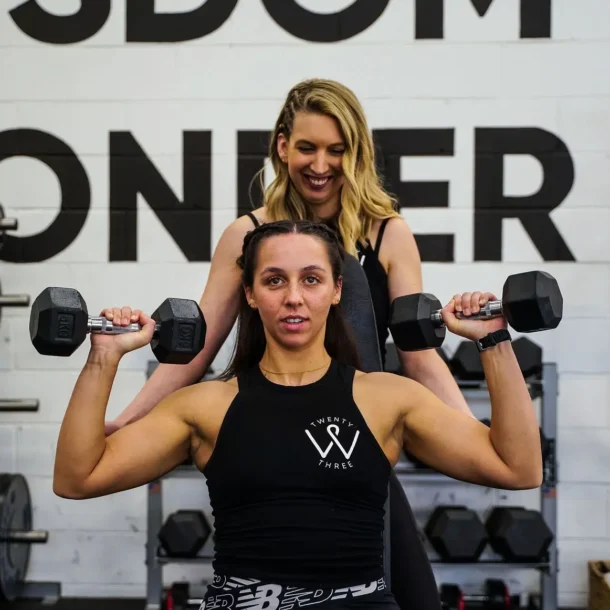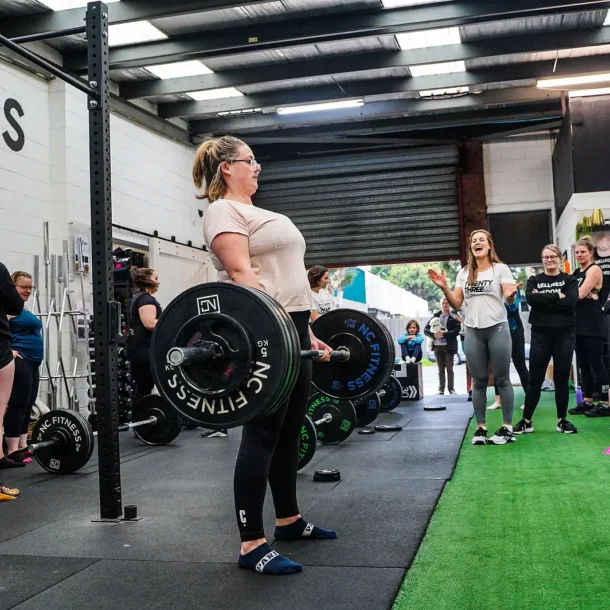

Most women’s fitness goals tend not to be too dissimilar. We want to be trim, get rid of anything that jiggles and add definition and tone in all the right spots. Thankfully, most women now understand that building muscle is one of the best strategies for sustained fat-loss and to develop the strong, lean and dam right sexy physique most women want to see in the mirror.
The results collected from our post 8-week winter challenge InBody scans, shone a spotlight on the numerous factors that enable women to lose body fat while maintaining lean muscle mass. As women, it is already hard enough to build metabolic tissue, losing it is usually the last thing most women actually want when trying to shed body fat.
In this article, we will discuss how you can optimise your body’s ability to lose weight without dropping muscle and hopefully continue to reinforce why weight loss and fat loss is not the same thing. If you are only looking at the bathroom scales as your only source of progress, it might be time to book an In Body or Dexa scan.
So, let’s get one this straight…weight Loss and fat loss is NOT the same thing.
Weight loss vs Fat Loss
Losing weight is easy! You can do it by going to the bathroom, cutting carbs for a few days (your body will store less water with less stored glycogen), reduce inflammation, you are dehydrated, or if you lose muscle or fat. Similarly, if you have a big weekend, don’t be that girl who whinges to her trainer that she has put on weight. Your scale weight might have gone up, but it is unlikely that you have put on fat. Fat gain happens after a sustained time in a calorie surplus and fat loss occurs after a sustained time in a caloric deficit. My main point here is that it all takes time. To see noticeable change in your body composition, you need to follow that same method/ process for weeks and months not a few days.
To be in a caloric deficit you need to eat less calories than your body needs. Knowing your resting metabolic rate can help you to work out how much food your body needs and then kind of deficit you need to be on.
Generally speaking you should be in 10-20% deficit of your maintenance calories.
Understanding a calories deficit
When you apply a caloric deficit, your body is forced to find an alternative fuel source to supplement the energy needed. This is where we see it dipping into its body fat stores, but unfortunately it can also mean you lean muscle tissue too.
This is a big reason why drastically cutting calories can be to your detriment in the long run. If you are a 65kg women who is moderately active and of medium height, your recommended calories (with a deficit) would be around 1600 calories and consuming at least 1.5- 2g of protein per kg of your body weight. This would be around 90-130g of protein daily. Many women jump on to something that looks more like a 1200-1500 calorie meal plan because they fall into the trap of thinking less is more.
A highly restrictive diet is likely to be less effective as the drastic energy drop does not allow you to fuel workouts adequately, making you more likely to strip muscle (along with fat) and increasing your exposure to a weakened immune system, a lower libido, and the list goes on. Unfortunately people are impatient. Further, this approach makes someone more likely to put the weight back on because the are more likely to yo yo with their diet coupled with less metabolically active tissue (muscle) which helps to fuel a humming metabolism.
Based on my years of experience training women of all shapes and sizes and our recent InBody scans, I have complied five of the best strategies to preserve muscle while you are trying to cut body fat.
When you train or exercise, you are breaking the body down. It is during recovery that the body rebuilds muscle tissue, making it stronger than before. Unfortunately, when there is an insufficient amount of protein available. A sufficient amount of protein in the diet will be the single most important factor in helping you lose body fat rather than muscle. A higher protein diet will also help you feel fuller and more content. Remembering that a caloric deficit is needed to lose fat, so unless you like feeling hungry… eat your protein.
To prevent your body from dropping muscle you must stimulate muscle growth with a suitable weight training program. Using a cardio approach alone will more likely lead to more weight being dropped from the muscle department.
Gradually increasing the weights lifted week to week will be important to build more muscle tissue. Keeping a track of this is the most important point of all. If you are able to squat 60kg for 10-12 reps, you aim should be to increase the weight on the bar. The general rule of progressive overload states that this should be around 10% every one- two weeks. Also understand that when you change your method of training, your body will respond accordingly too. For example, if you go from 4 weight training sessions per week to 2 weight training sessions and add 2 cardio-based sessions. Your body will recognise this and think that the muscle is not needed for the purpose to lift heavy and start to burn it as fuel.
If you have been weight training for some time, do not be surprised that it becomes near impossible to build muscle on a caloric deficit. If your coach is suggesting more food is needed to put muscle on, embrace it. More lean muscle tissue will help you to develop the lean, toned and athletic body you have been searching for.
Firstly, I want to clarify what these two terms mean. Frequency, is the number of sessions per week and volume is a term that represent the total amount of work in a session. It can be calculated by multiplying your reps by sets.
Overtraining, and not giving your body enough time to recovery is a sure-fire way not to build muscle. This a battle I have with myself on a daily basis. Why? Because I love to train. And I love the way training makes me feel. But there is a down side. If I am shortening my time between training session from 48 – 24 hours, I am shortening the time for my muscle tissue to repair and grow. Ultimately this will affect the amount of muscle I can put on and maintain and not recovering properly from your workouts.
This can be prevented by adding in rest days to your program or reducing your training volume (reducing the reps or sets). Do not under estimate the power of a rest day to make you feel more motivated to train the day after. If you cannot stand the thought of sitting still, aim to be as active as possible in your day by adding in a long walk or yoga.
Calorie or nutrient cycling is an easy component to understand. It means eating more calories on your training days and less on your rest days. When you train you have a higher demand for carbs and calories to fuel your workouts and recovery, while on rest days your nutrient split could be higher in fats, with less calories. However, while you eat more food on some days and less on others, your average calories across the week should still put you in a deficit. This technique can also make you more compliant to your diet as it is a more satisfying and intuitive approach to eating.
Cardio is great. Sometimes there is nothing better than getting the heart pumping and sweat on. But understand that it is more likely to lead to muscle loss because your body does not recognise the need to be strong while you are doing it.
In fact, if you think cardio alone will help put you in a deficit, you are wrong. Cardio and exercise in general burns a tiny number of calories in comparison to your overall daily recommended intake. If you want to lose fat, you need to watch what is going in your mouth. On a personal note, high volumes of cardio and really intense sessions tends to make sticking my diet more difficult as start to crave more food and carbs. Making me less diet adherent to my fat loss goals.
Where to from here?
23W is a women’s only training facility that prioritises strength-based training to help women look and feel like an athlete. Our programs are specifically designed to help women build muscle, learn how to lift and get strong. We also work with women to set individual nutrition plans that are tailored to their goals.
If you would like more information about our programs and joining our tribe, check us out here.
Would you like to come meet us? We are running a free Open Morning on Saturday 6th, October. Register to attend via our timetable.

Ange Drake is an personal trainer, women’s empowerment coach and fitness blogger in the northern suburbs of Melbourne. She is the director of one of the few womens’ only strength training gyms in Melbourne, 23W. Ange helps women to learn how to use strength based training, nutritional strategies and a positive mindset to transform their bodies, relationship with food and mind.
Can’t decide which of our packages is best suited for you? Take our questionnaire to help you decide!





